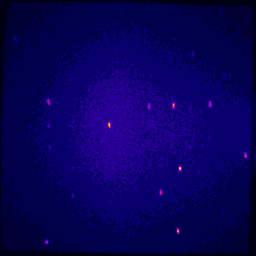Protonation states of proteins
Neutron crystallography locates the hydrogen atom positions in protein crystals, which are not properly seen by X-rays. The Bragg-reflections from a sperm whale myoglobin crystal measured with the BioDiff instrument, a dedicated instrument for neutron protein crystallography at MLZ in Garching together with the resulting protein structure is shown below. The additional information gained with neutron protein crystallography is for example the identification of unusual hydrogen bonds, the protonation state of amino acid side chains and the solvent structure in and around the protein [1]. Also, in the case of metalloenzymes, neutron crystallography often shows the true picture avoiding the radiation damage present in x-ray crystallography [2]. For more information see: https://mlz-garching.de/biodiff
Unfortunately, large protein crystals are required for this method. In order to grow these large crystals detailed knowledge on the phase diagram of the corresponding protein is required. Also, more understanding of the processes involved in crystallization is desired. Among other techniques, neutron small angle scattering in combination with in-situ dynamic light scattering and quasi-in-situ static light scattering is especially well suited to follow the crystallization process in real time. Dedicated effort is put into the development of such techniques to provide more information on the crystal nucleation and growth process [3].


References:
- Johannes Schiebel, Roberto Gaspari, Tobias Wulsdorf, Khang Ngo, Christian Sohn, Tobias E. Schrader, Andrea Cavalli, Andreas Ostermann , Andreas Heine and Gerhard Klebe,
Intriguing role of water in protein-ligand binding studied by neutron crystallography on trypsin complexes
NATURE COMMUNICATIONS 9, 3559 (2018) - Hanna Kwon, Jaswir Basran, Juliette M. Devos, Reynier Suardíaz, Marc W. van der Kamp, Adrian J. Mulholland, Tobias E. Schrader, Andreas Ostermann, Matthew P. Blakeley, Peter C. E. Moody, and Emma L. Raven,
Visualizing the protons in a metalloenzyme electronproton transfer pathway
PNAS 117 (12), 6484 (2020) - R. J. Heigl, M. Longo, J. Stellbrink, A. Radulescu, R. Schweins, and T. E. Schrader,
Crossover from a Linear to a Branched Growth Regime in theCrystallization of Lysozyme
Cryst. Growth Des. 18, 1483 (2018)
Contact:
Phone: +49 2461 61-4502
Email: a.stadler@fz-juelich.de

Phone: +49 89/158860-743
email: t.schrader@fz-juelich.de


